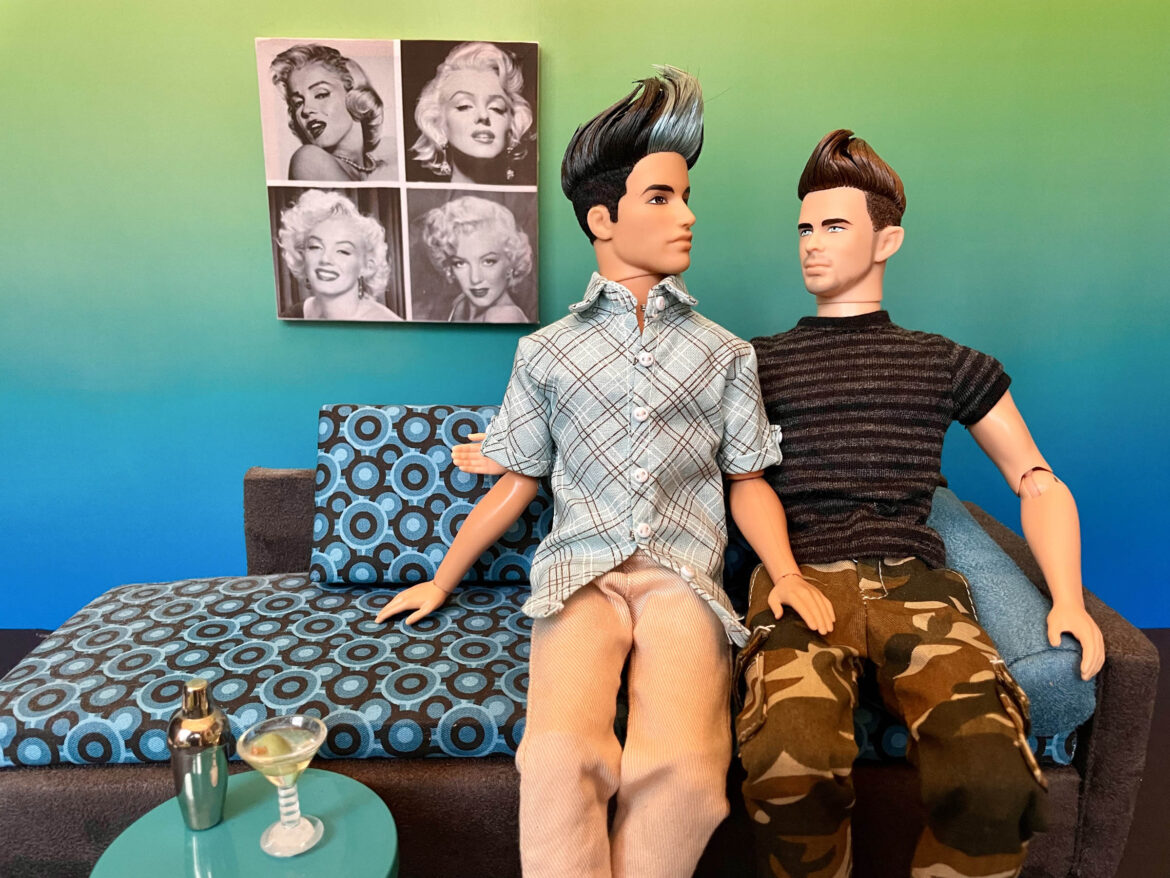When a mutual friend introduced them at a party in Burlington, this gay couple did not expect that their happily-ever-after would include a family of about 600 Barbie dolls.
Today the dolls are labeled and shelved, stored in cupboards and closets, nooks and crannies, bins and boxes, carefully preserved with affection and attention, with more to come—if there’s room.

Peter Harrigan and His Barbie Collection (Photo by Jerry Swope)
Married since 2010, Peter Harrigan (@play_house_with_peter), a theatre director at St. Michael’s College and Stan Baker, a psychotherapist and also the Archdeacon of the Episcopal Church of Vermont, began their collection when, for Peter’s birthday in 1993, Stan presented him with a Costume Ball Barbie. “It was my attempt at therapy, because in childhood Peter had secretly played with his sister’s Barbie dolls,” Stan says.

Peter & Stan (Photo Courtesy of Peter Harrigan)
Today, their 2,200 square-foot condo in the movie-set town of Shelburne, Vermont, houses not only the dolls but their accessories: clothes, shoes, purses, wigs, cellphones, and clocks, for starters. Miraculously, their owners know where each figure lives. They can find their comb and brush, hairstyler or what have you, as well.
It’s not a random assembly. Not only are the dolls carefully curated, but they are grouped in dioramas, which gives them context and an identity. “It’s not how many there are, it’s having fun with them,” Peter says, adding, “They all play well together”.
There are trendy boutique doll gatherings: imagine Project Runway, a Tikibar, or Christmas themes, and of course, there are Barbie gentlemen, easily recognizable, as they are clustered together in an obviously LGBTQ group. There is a Wizard of Oz tableau and the lookalike individual figures of Frida Kahlo, RuPaul, Queen Elizabeth II, and Marilyn Monroe, of course. Barbie with short hair is a rare specimen, and Peter mentioned an Indian wedding grouping with facial piercings and traditional wedding dresses, of which he is especially proud.

RuPaul Barbie (Photo by Peter Harrigan)

Short Hair Barbie (Photo by Peter Harrigan)
Barbie’s BF, handsome Ken, is here in many iterations. Stan’s inclination is to collect the Kens. “I preferred collecting the Kens, because there were a finite number, those made between 1961 and 1969, the vintage group. Although Ken used to be called ‘a purse with legs’ that’s changed. He’s represented in all sorts of ethnicities now.”
Both Stan and Peter are responsible for including diversity in their assembly, but not only in racial multiplicity. Their dolls have not excluded examples of the disabled. Here’s Barbie in a wheelchair, Barbie with a prosthetic leg and even a vitiligo doll (she has a complexion that shows white patches, the typical pigment-loss symptom of the disease.)

Queen Elizabeth II Barbie (Photo by Peter Harrigan)

Marilyn and Ken (Photo by Peter Harrigan)

Madonna Made Me Gay (Photo by Peter Harrigan)

Frida Kahlo Barbie (Photo by Peter Harrigan)
In keeping with their devotion to individuality, fairness, and human rights, in 1997 Stan and Peter became major players in Vermont’s push for Marriage Equality. They were a part of a lawsuit to legalize Civil Unions for same-sex couples. That win in 2000 led to Vermont’s legalizing gay marriage in 2009, the fourth state in the United States to do so. This is a major footnote in the couple’s and the state’s history and is recorded for posterity as the Baker Decision.
The small town of Shelburne in which Stan and Peter chose to live is twenty minute drive from Burlington, and it has charisma at every turn. This hamlet of 7000 is known for its world-class Shelburne Museum, its antique shops and boutiques, cozy restaurants, and the family-friendly Teddy bear Museum. Shelburne Vineyards, pioneers of bringing wine and cider go together, has occasional concerts and tastings. Shelburne Farms, a non-profit enterprise, is also relevant here. Go to enjoy nature, hiking, and learning its lessons in sustainability.
Shelburne itself is emblematic of the idyllic, feel-good weekends available in the gay-welcoming state of Vermont where Barbie is celebrated for her diversity.

Multicultural Barbie (Photo by Peter Harrigan)


